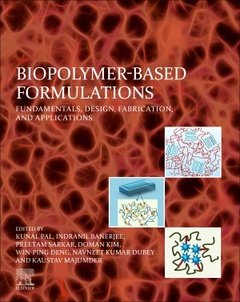Biopolymer-Based Formulations Biomedical and Food Applications
Coordonnateurs : Pal Kunal, Banerjee Indranil, Sarkar Preetam, Kim Doman, Deng Win-Ping, Dubey Navneet Kumar, Majumder Kaustav

Biopolymer-Based Formulations: Biomedical and Food Applications presents the latest advances in the synthesis and characterization of advanced biopolymeric formulations and their state-of-the-art applications across biomedicine and food science. Sections cover the fundamentals, applications, future trends, environmental, ethical and medical considerations, and biopolymeric architectures that are organized in nano, micro and macro scales. The final section of the book focuses on novel applications and recent developments. This book is an essential resource for researchers, scientists and advanced students in biopolymer science, polymer science, polymer chemistry, polymer composites, plastics engineering, biomaterials, materials science, biomedical engineering, and more.
It will also be of interest to R&D professionals, scientists and engineers across the plastics, food, biomedical and pharmaceutical industries.
1. Introduction of biopolymers: food and biomedical applications2. Enzymatic synthesis of flavonoid glucosides and their biochemical characterization3. Fish gelatin: molecular interactions and applications4. Peptides as biopolymers: past, present, and future5. Microbial production of biopolymers with potential biotechnological applications6. Animal-derived biopolymers in food and biomedical Technology7. Application of CRISPR technology to the high production of Biopolymers8. Biomedical and food applications of biopolymer-based Liposome9. Nanosized magnetic particles for cancer theranostics10. Core-shell biopolymer nanoparticles12. Nanotechnology-based sensors13. Functional amyloids14. Lipid-derived renewable amphiphilic nanocarriers for drug delivery, biopolymer-based formulations: biomedical and food applications15. Nanoencapsulation of nutraceutical ingredients16. Nutraceutical encapsulation and delivery system for type 2 diabetes mellitus17. Pickering emulsions stabilized by nanoparticles18. Microencapsulation of bioactive compounds and enzymes for therapeutic applications19. Rice husk silica for the stabilization of food-grade oil-in-water (O/W) emulsions20. Oil-entrapped films21. Tamarind seed polysaccharide: unique profile of properties and applications22. Thermomechanical and surface morphology of biopolymer/nanoparticle composite films23. Natural and bioderived molecular gelator-based oleogels and their applications24. Hydrogels as biodegradable biopolymer formulations25. Biopolymer-based oleocolloids26. Gum-based hydrogels in drug delivery27. Implant surface modification strategies through antibacterial and bioactive components28. Edible films and coatings: an update on recent advances29. Rheology and tribology assessment of foods: a food oral processing perspective30. Biopolymer-based scaffolds: development and biomedical Applications31. Phenolic nanoconjugates and its application in food32. Oleogels for food applications33. CNT-tamarind gum-based solid-textured composite hydrogels for drug delivery applications34. Testicular tissue engineering: an emerging solution for in vitro spermatogenesis35. Enrichment of edible coatings and films with plant extracts or essential oils for the preservation of fruits and vegetables36. Collagen-based 3D structures - versatile, efficient materials for biomedical applications
Researchers, scientists and (post)graduate students in the areas of biopolymers, polymer science, polymer chemistry, polymer composites, plastics engineering, biomaterials, materials science, nanotechnology, biomedical engineering, food science, and medicine. Scientists, R&D professionals, designers and engineers across industries and disciplines, including plastics, food, biomedicine, and molecular imaging
Prof. Indranil Banerjee did his Ph. D. in Biotechnology (Tissue Engineering) from Indian Institute of Technology Kharagpur, India in the year 2011. Presently, is holding the position of an Assistant Professor in the Department of Biotechnology and Medical Engineering at National Institute of Technology- Rourkela. He is the Professor-in-Charge of the Bioprocess Laboratory and Biomicrofludics Laboratory. His group is actively involved in understanding the cell physiology in response to biomaterials developed on a length scale (nano to macro). He was a visiting scientist in Maxplanck Institute of Intelligent System, Germany. Dr. Banerjee has authored 35 SCI cited publications in various journals of repute with a total citation of more than 450. He is also serving as industrial consultant.
Dr. Preetam Sarkar is an Assistant Professor of Food Sciences at the Department of Food Process Engineering, National Institute of Technology Rourkela, Odisha, India. He completed his Ph.D. in Food Sciences from Purdue University, USA. The research at Dr. Sarkar’s lab at NIT Rourkela focuses on the development of delivery vehicles such as emulsions, films and coatings, for the protection of bioactive compounds such as antimicrobial agents for food safety applications. He has published 30 articles in SCI journals, 10 book chapters, and co-edited 3 books.
Prof. Kim is a Professor in the Department of International Agricultural Technology at Seoul National University. He also serves as a Director of the Institute of Food Industrialization, Institute
- Provides in-depth coverage of methods for the characterization of the physical properties of biopolymeric architectures
- Supports a range of novel applications, including scaffolds, implant coatings, drug delivery, and nutraceutical encapsulation systems
- Includes the use of experimental data and mathematical modeling, thus enabling the reader to analyze and compare the properties of different polymeric gels
Date de parution : 01-2020
Ouvrage de 966 p.
19x23.3 cm
Thèmes de Biopolymer-Based Formulations :
Mots-clés :
Acylglycerols; Alginate; Amphiphilic polymers; Amyloids; Antiinflammation; Antimicrobials; Antioxidant; Antioxidants; Applications; Bakery products; Beta sheet; Bioaccessibility; Bioactive compounds; Bioavailability; Biocompatibility; Bioengineering; Bioink; Biomaterials; Biomedical; Biopolymer; Biopolymers; Biosensors; Bone; Carbon nanotubes; Carbon; Carboxymethylcellulose; Chitosan; Coatings; Collagen; Complex coacervation; Conjugates; Controlled release; Core–shell nanoparticles; CRISPRi; Degenerative disease; Delivery system; Digestion; Dressing; Drug delivery system; Drug delivery; Edible films; Elongation at break; Emulsion stability; Emulsions; Encapsulation; Enzymatic synthesis; Enzymes; Essential oils; Exopolysaccharide; Fat replacers; Films; Fish gelatin; Flavonoid; Flavor; Foams; Food; Food-based applications; Foodborne pathogens; Food-grade biopolymers; Freeze-thaw technique; Frozen dessert; Fruits; Gelatin; Gelation; Gelling; Gels; Gene-activated matrix; Glass transition temperature; GLUT5Transglycosylation; Gold; gTME



